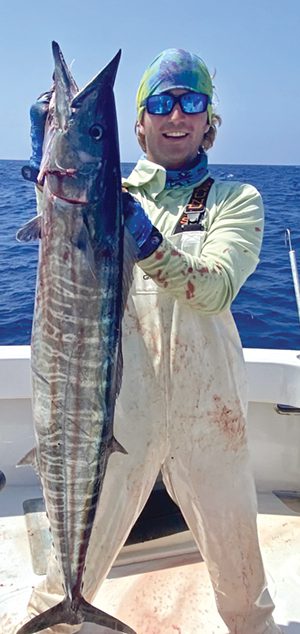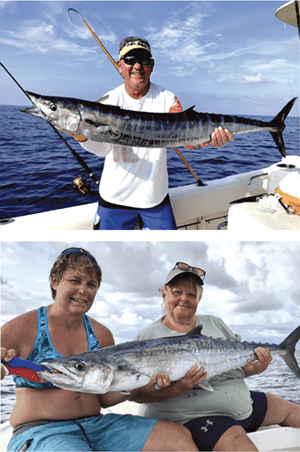
We have four types of mackerel. Here are the best techniques, places, and times to catch the various species.
Spanish Mackerel – smallest sized mackerel, and probably the most plentiful. Spanish mackerel can be easily identified by their bright yellow polka dots. We like to target spanish mackerel in the spring and fall in close when the weather is mild as they don’t like it too hot or too cold. We typically target Spanish mackerel at the reef lines in the Atlantic, and 8 or 10 miles out in the Gulf of Mexico. The best technique to catch spanish mackerel is with a block of chum and a chum ring using live pilchers pictorial hooked with a long shank J hook or artificial bait, such as silver, spoons and red and white feather jigs. Many times will tip the jigs with live shrimp hooked up to the chin through the top of the head missing the brain, and making the hook flush with the shrimps horn and jigging it through the mid column of the water. Many people feel that spanish mackerel are a fishy tasting oily fish, best smoked, grilled or baked. The season is open year-round, you can keep up to 15, and they must measure 12 inches from the tip of the top lip to the fork of the tail down the lateral line of the fish.
Cero Mackerel – second smallest of the Florida Keys mackerel, and probably the second most plentiful. Easily identifiable by its yellow dashes and thick yellow lateral line. Cero mackerel, season is open year-round. There is no size limit for cero mackerel but there is a 100 pound per day per person bag limit. We like to target cero mackerel during the same time and places as spanish mackerel. Both spanish and cero mackerel are best targeted in the middle of the day. We typically don’t catch them early in the morning or late in the afternoon. We use the same techniques to catch cero mackerel as we do spanish, however, since cero mackerel are a bit larger than spanish mackerel on the average, we do best targeting them with large pilcher’s hooked in the nose plate with a long shank J hook. Since mackerel are such toothy critters, if the water is murky, we like to use a 6- or 8-inch piece of 25lb. test wire leader to the hook. If the water is clear, the mackerel are smart enough to see the wire leader and we have to use a 20 or 40lb. mono fluorocarbon leader. When using mono rather than wire, we lose more fish, but we get more hits. Cero mackerel taste very similar to wahoo, which many people say is their number one tasting table fare. Less fishy tasting and less oily and then a spanish mackerel. Cero mackerel can only be caught in the Florida Keys waters and south. For example, I’ve never caught one north of Fort Myers on the West Coast of Florida or north of Palm Beach on the east coast of Florida.

Wahoo – Is the largest of the Mackerel family and the rarest. Wahoo is considered by most anglers as a trophy fish because they’re so hard to target and catch and because of their unique beauty and unreal fight. Wahoo have beautiful tiger striped colors with hues of blue, black and purple. Wahoo are the fasted fish in the ocean clocked at over 60 miles per hour. Many times, we’ll high speed troll with an in-line weight rigged with a cable and troll a black and purple plastic Tormenter Lure on 250lb. test mono leader 100 ft long at 14 mph. For a wahoo to feed at 14 mph is nothing for a wahoo. We also troll at 6 or 8 mph with pink and purple No Mad lures. Target wahoo on wrecks and ledges using live baby bonita free lined or under a balloon. If we find a floater offshore, we like to vertical jig for wahoo. The fall and winter months are the best time of year to target wahoo especially during the full moon on a no wind blue bird day. Like the other mackerel, wahoo season is open year-round. Wahoo has no size limit but has a bag limit of 2 per day per angler. Wahoo is my favorite fish to fight and to eat.
As we enter into fall season, we anticipate an awesome mackerel season. Come down to the Florida Keys and experience one of the most exciting species of fish in the world, mackerel!
